OLPC in Uruguay: Impressions of Plan Ceibal’s Primary School XO Laptop Saturation
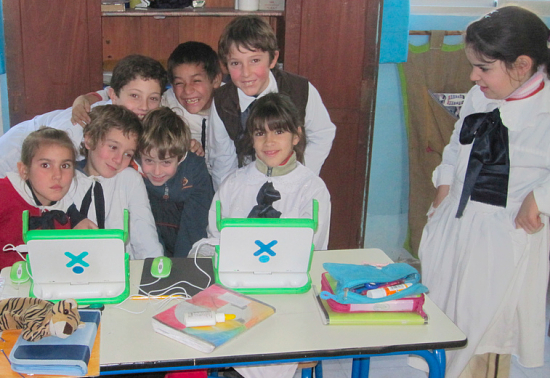
.
If there’s one country that has taken the notion of “one laptop per child” very seriously then it’s Uruguay.
As mentioned in the OLPC in South America introduction to date the country has distributed approximately 400,000 of OLPC’s XO-1 laptops, thereby equipping every single pupil and 18,000 teachers of its public primary education system with a laptop. Not stopping there, the country is now in the process of rolling out 100,000 laptops – 90,000 of them being OLPC XO-1.5 HS machines, with the remaining 10,000 being Intel Classmates – in its secondary education system.
Switzerland of South America
It’s not hard to argue that in many ways Uruguay presented the perfect environment for a country-wide 1-to-1 computing in education project. Pretty much regardless of which metric one looks at, Uruguay is always in the upper segments, particularly within the South American context:
- Literacy Rate: 98%
- Human Development Index (HDI): 0.865
- GDP per capita: $10,079 (2009)
- Internet users: 40 per 100 (2008)
Especially when it comes to primary education, Uruguay provided a stable foundation to build on given that practically every pupil finishes the six years of primary school and as a result literacy levels are very high. At the same time the physical infrastructure in terms of reliable access to electricity and the Internet also existed in many parts of the country.
It’s within this context that then-president Tabaré Vázquez first announced “Plan Ceibal” – Ceibal being both the acronym for Conectividad Educativa de Informática Básica para el Aprendizaje en Línea – Basic educational connectivity for online learning as well as being an emblematic Uruguayan plant. The corresponding presidential decree was signed in mid-April 2007 and in then-president Vázquez’s own words:
“[Plan Ceibal’s] longer-term objective is to promote social justice by promoting equal access to information and communication tools for all our people.”
Distributing the aforementioned 400,000 XO-1 laptops was thereby the first step of a larger process, and that ambitious first goal was completed at the end of 2009. Hence Uruguay is the first country to achieve full device saturation in its public primary school system. This makes the county and excellent example of having transitioned from the “should we do it” and “which technology do we use” stage to the more important, and more complicated, question of “how do we do it”?
Status quo
Now as indicated in the introduction the main indicators of Plan Ceibal I was looking at during the two weeks I spent in Uruguay in July are what I call the six criteria for successful implementations of ICT for Education projects in developing countries.
1. Infrastructure
On a logistical side it is impressive to see how approximately 400,000 OLPC XO-1 laptops were distributed within 24 months. An interesting side-effect of that distribution was that the country discovered several thousand children which previously hadn’t been officially registered. Registering the children included them and their families in social services and support.
Almost all of the schools are connected to the country’s electricity network. The few remaining schools are planned to receive solar panels over the coming months with 10 schools currently being part of a pilot project to get the details right.
In terms of Internet connectivity, 98% of the primary schools involved with the program now have Internet access and 150,000 children can walk less than 300m to the next public WiFi hotspot. Additionally various community and youth centers, cooperatives, and other organizations have started providing public WiFi hotspots in many cities and towns across the country. An important note to make, is that Plan Ceibal closely collaborated with ANTEL, Uruguay’s largest telecommunications company which is government-owned, to provide this high degree of connectivity at a subsidized price.
Going a step further, Plan Ceibal also developed Canal Ceibal which is a special television program that is focused on presenting various ways and methods of how the XOs can be used for learning. The program is broadcast over the cable network and more recently the various segments have also been uploaded to YouTube.
As of early October more than 200 videos had been made available and Uruguayan volunteers recently compiled a detailed overview of approximately 50 videos that show which subject, grade, and software is being demonstrated.
All of these activities are coordinated by approximately 180 people who work at a newly created organizational unit called CITS (Centro para la Inclusión Tecnológica y Social – Center for Technological and Social Inclusion) within LATU (Laboratorio Tecnológico del Uruguay – Technology Laboratory of Uruguay). LATU is the organization that then-president Vázquez had tasked with executing the technical and operational implemention of Plan Ceibal. This is an interesting decision given that in most cases it’s the Ministry of Education itself which runs ICT4E projects.
So in terms of the infrastructure it has built up Plan Ceibal is undoubtedly very impressive and will greatly benefit from this solid foundation in the future.
2. Maintenance
One of the biggest issues that Plan Ceibal has encountered so far is extensive breakage of the XO-1 laptops it has distributed. An official survey earlier this year found that 14,2% of the laptops were broken in one way or another and that an another 13,2% were in an “unusable state” due to currently undergoing a repair process, being locked down by the country’s XO security system or a variety of other issues.
Assuming that the results of the survey are representative for the whole country this means that in total 27,4% of the laptops – more than 100,000 in total – weren’t usable as of April 2010. Similarly an independent report by volunteers of the RAP Ceibal San Jose group that was released in August 2010 indicated that only 68,3% of the XOs in the surveyed homes were working without any issues.
Plan Ceibal has since been working hard to adapt and improve its maintenance system in order to deal with this issue. Originally all of the broken laptops were repaired in a central facility in Montevideo. This required parents to contact a call-center, receive a shipping number, and then go to a post-office from where the XO was sent in free of charge. The repair center then evaluated whether the breakage was covered by the warranty provided by the government or whether the parents had to pay a fee for the repair.
This approach proved to have some limitations as people didn’t know the phone number of the call center, were reluctant to call it due to fear of an expensive phone call, weren’t willing to send their children’s XOs away via the post office, and had a variety of other concerns. This lead to the situation where only a third (official survey) or fourth (RAP Ceibal survey) of the broken machines had actually been sent in for repair.
In the recent months Plan Ceibal has expanded its repair process via several significant steps. The first one was to establish about a dozen mobile repair teams which go out and visit schools, particularly in rural areas. As many laptops as possible are fixed on-site with the remaining ones being entered into the repair system.
Secondly the project has started partnerships with already existing computer-repair shops and businesses across the country. They are taught how to repair XO laptops and then serve as local repair facilities in their respective cities and regions.
Additionally Plan Ceibal has built up significant capabilities when it comes to being able to deal with complex breakages. Previously these would have meant that an XO or its motherboard would have to be discarded. Thanks to investing in special equipment and training staff they can now do a lot complex repairs – such as ones of broken motherboard chips – in-country. Similarly Plan Ceibal has closely collaborated with OLPC’s engineering team to work on improvements of the XO laptops to address certain weaknesses. One example is the thickness of the XO-1’s keyboard membrane which was increased after reports of keys frequently ripping off after a few months of use.
All of these measures however only cover scenarios where the laptops are already broken. An equally important area to focus on is the mitigation of these breakages. To that end some volunteers in Montevideo as well as other cities have started organizing parent information events before the laptops are handed out in the first grades. While no evaluation has been done to record the effects of these meetings, many volunteers agreed that they’ve seen significant drops in the number of broken machines in schools where parents were told that the XO is an important learning tool for their children and not, as it is often perceived, a toy.
Overall I believe that Plan Ceibal will soon be able to address the high breakage rates they’re currently seeing. This process could likely be both accelerated as well as improved by dedicating more resources to mitigation-strategies as well as extensive outreach to schools and communities in critical urban and rural contexts.
If you’re interested in more information about this topic then I’d recommend reading the article XO Breakage Rates and Mitigation Strategies in Uruguay which I published on OLPC News back in July.
3. Contents and materials
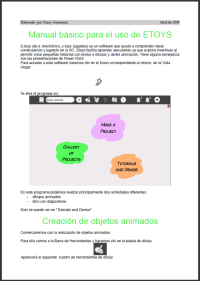
A basic manual for eToys
One of the key components of any ICT4E initiative is the educational content and materials that pupils as well as teachers use for learning and teaching. Now an interesting aspect here is that people define “educational content” in many different ways.
Some argue that a country’s curriculum is that educational content since it contains a list of all the things pupils should know and be able to do at a certain age. Hence the argument goes that the only question that needs to be worked on is how this content will be taught with the help of new tools such as the XO laptops.
On the other hand there are people who strongly believe that the use of technology enables new forms of content, and this content needs to be specifically developed. Current content is seen as only making use of the benefits provided by current tools such as chalkboards, books, pens and paper.
Plan Ceibal in many ways tries to embrace both approaches. Ceibal’s teacher training (see the corresponding section below for more details) has generally been focused on how to use the existing Activities that the XO laptops are shipped with for different subject areas and grades. At the same time Plan Ceibal has supported the development of new educational software and content in a variety of ways and helps distribute it via Plan Ceibal’s Educational Portal.
One example of new content creation are idea competitions where teachers can submit their own visions of educational content or software. The best submissions are selected by a jury and subsequently funding is made available to turn the initial idea into a digital learning object.
A second approach are open competitions for companies or organizations. CITS basically puts out a call for these entities to submit their software or content for review with the goal to obtain limited rights to distribute the best submissions on the XOs in its school system.
A third model is when CITS asks companies for bids to write a specific type of software such as for example a system which helps teachers keep track of pupils’ attendance.
Last but not least there are also external competitions which are run by other organizations or companies. The resulting software and content are vetted by CITS before they’re distributed via inclusion in the standard software release or Plan Ceibal’s Educational Portal. One example of this model was used for a game which resulted from a competition originally organized by the Ministry of Tourism.
The result of all these efforts is a collection of content and materials which is mainly made available via the aforementioned Plan Ceibal Educational Portal. This collection of approximately 500 different objects includes a broad variety of media such as online resources, games, videos, tutorials, guides, as well as links to other Web sites. In terms of subject areas it covers arts, language, mathematics, natural sciences, social sciences, and foreign languages. There are also a number of materials with a health-related focus such as Dengue fever and the dangers of smoking.
The impression I got after speaking to a variety of people in Uruguay is that although these materials exist and are available to pupils and teachers – thanks to the near ubiquity of Internet access in schools – there’s a lack of knowledge of how to actually use and integrate them in the classroom context. Additionally some teachers mentioned being overwhelmed by the broad variety of choices with a subject area rather than being able to rely on a single text book as it’s generally been the case up to now.
This impression might be related to teacher training, yet it shows that simply making content available isn’t enough to ensure that it’s being (effectively) used for learning. One way to approach this issue could be to include guides and support materials for teachers – and possibly also parents – which help them understand how to use each content object with the pupils.
At the end of the day it seems to be clear that digital learning content and materials will need additional support as they’re being phased into the education system in order to convince teachers to use them rather than tried and trusted tools such as text books.
4. Community inclusion
Due to both its vision and its size Plan Ceibal has attracted a variety of entities outside of the official implementation organization CITS who are contributing to the project with a variety of efforts. These initiatives and groups of people play a key role in reaching out to a variety of stakeholders, such as parents, teachers, and school administrators and generally addressing what they perceive to be gaps in the official initiative.
Three initiatives are particularly noteworthy in this context:
Flor de Ceibo is a community outreach project that was started at Universidad de la República – Uruguay’s largest university – in 2008. The program’s three main goals are:
- To create an enabling space for participation in the ongoing and interdisciplinary national effort that is Plan Ceibal.
- To contribute to the closing of the digital divide by involving university students in Plan Ceibal.
- To enable new forms of collaboration between the university and the broader society.
In order to achieve these goals both professors as well as several hundred students are working on a broad variety of projects, e.g. special programs for single-mothers, in this area.
ceibalJAM is an independent NGO that is focused on developing high-quality software and content for learning. Some examples of work ceibalJAM has supported are:
- Conozco Uruguay, a Sugar Activity for learning about Uruguay’s geography.
- JAMedia which turns every XO into a TV and radio tuned to Uruguayan online channels as well as being a versatile video- and audio-player.
Additionally ceibalJAM is regularly organizing events and meetings in Montevideo that bring together teachers, parents, students, artists, and other people who are interested in learning more about Plan Ceibal and how to contribute to the project.
Last but not least RAP Ceibal (Red de Apoyo al Plan Ceibal – Support Network for Plan Ceibal) is a volunteer network of individuals and groups of people supporting Plan Ceibal in many different ways. These cover basic activities such as handing out and repairing XOs as well as the previously mentioned compiling of surveys about the state and use of the XOs or introducing parents to Plan Ceibal in general and the XOs in particular.
At one point, 50,000 XOs across the country refused to boot due to a software issue and only the large-scale participation of RAP Ceibal volunteers enabled the issue to be resolved in a relatively short period of time. (More information about RAP Ceibal can be found in the RAP Ceibal – Uruguay’s volunteer network article on OLPC News.)
Additionally some groups and organizations are working on more temporary efforts within the context of Plan Ceibal. One example is eXpO fotos: an exhibition based on photos taken by pupils with their XOs during a series of photography workshops run by a museum in Montevideo.
The situation in Uruguay offers interesting insights into the role the various groups mentioned above as well as others play in ensuring the sustainability of a project such as Plan Ceibal. The case of the 50,000 disabled XOs is an important example that shows how informal communities or independent NGOs can often address needs and situations that more traditional organizations and hierarchies such as Ministries of Education – or in Uruguay’s case CITS – aren’t well equipped to deal with. Similarly these entities can provide grassroots, community, and service components that are often underestimated key factor in ensuring the support and buy-in of stakeholders such as parents, teachers, and school administrators.
5. Teacher training
Teacher training within the context of Plan Ceibal has undergone a number of iterations over the past three years. With the pilot project in 2007 no teacher training took place before the laptops were handed out which led to a variety of issues.
In 2008 the training was focused on building capacity of regional inspectors as well as informatics teachers who were in turn supposed to train all the other teachers in their region or school. This approach combined with a broader lack of understanding of the laptop’s abilities and potential resulted in the training being too focused on how to use the machine itself, and not focused on how to use it in the learning process.
In 2009 the concept of champion teachers and “formadores” (teacher trainers) who were meant to lead and inspire by example was introduced. It turned out that the several dozen people in these roles, in combination with a revamped training program that focused on learning how to use individual applications, also didn’t have the desired large-scale impact.
Now in 2010 the training program was again radically redesigned. This process was still in somewhat of a limited pilot phase when I visited Uruguay in July, and it is supposed to be introduced nation-wide towards the end of the year. So it remains to be seen how things will work out over the next 12 to 18 months. In any case some key components of this new model are:
- The introduction of support roles such as “maestros de apoyo Ceibal” (Ceibal support teachers) and “amigo Ceibal” (Ceibal friend) who train and help teachers both inside as well as outside the classroom
- The creation of groups and meetings in and between schools to facilitate the exchange of experiences
- The start of the television program Canal Ceibal
- The inclusion of distance learning via a learning platform built around Moodle
- A redesign of Plan Ceibal’s Educational Portal
- Separate training sessions for teachers working in special schools
Given the large scale and long-term vision of Plan Ceibal another important component are efforts to better integrate the knowledge about the educational use of technology in the education and career paths for future teachers. While some ideas and initiatives in this area were discussed, to me it seems like there’s a lack of a comprehensive plan which ensures that the next generation of teachers is well versed in the tools they will encounter in the classrooms.
Overall I would argue that teacher training efforts within Plan Ceibal are still in an early experimental stage. Different approaches have been tried out over the past three years but it seems like none of them managed to meet the required combination of effectiveness and efficiency. As a result the 18,000 teachers aren’t utilizing the laptops as extensively and effectively as envisioned.
There’s no doubt that good teacher training is one of the most important, complex, and expensive parts of any ICT for Education project. While not having been able to completely solve this puzzle yet Uruguay’s experiences do point to what a suitable solution could look like:
- Training that takes place before the laptops are handed out combined with in-service training and in-classroom support
- Training components that take place in both physical and virtual environments
- Training that is really focused on how to use the laptop for learning rather than spending too much time on simply learning how to use a particular application
- Creating suitable spaces for teachers to exchange ideas, experiences, and materials they made while using the laptops
- Inclusion of training of methods and abilities required for using connected digital tools in schools in the education of future generations of teachers
6. Evaluation
Given that Uruguay is the first major country to actually have given a laptop to every child in its primary school system there’s of course a significant amount of interest – both inside as well as outside the country – in seeing what the results and impacts of Plan Ceibal are.
In broad terms there are two different categories of impacts that are being evaluated in ICT4E projects, and Plan Ceibal is no different here:
Educational impacts can cover a broad variety of topics such as school attendance rates, attitudes towards school and learning, grades, cognitive skills, acquisition of ICT abilities and many other metrics.
Social impacts can include looking at secondary users and potential beneficiaries of ICT4E projects, the reduction of the digital divide, use of the Internet outside of school, use of Internet based communication services such as e-mail and other aspects concerning the use and impacts of laptops outside the education setting.
An interesting development in Uruguay is that there several evaluation efforts are underway in parallel. CITS itself has a small team of pedagogists and sociologists whose work encompasses both the educational and the social dimension. Additionally an independent project called ILATIS is evaluating Plan Ceibal as part of a larger effort to compare four different ICT4E projects in Argentina, Colombia, Costa Rica, and Uruguay. Most recently a local sub-chapter of the previously mentioned RAP Ceibal volunteer network has undertaken its own study to get a better understanding of how the laptops are being used.
It’s important to note that the majority of the evaluations are still in relatively early stages given that the distribution of the XOs was only completed in late 2009, and hence many schools have barely had them for a year.
Yet when looking at evaluations as a tool for continually monitoring developments it becomes clear that even though in many cases it’s too early to draw any final conclusions there are some trends which can already be observed.
One important comment at this point is that CITS isn’t particularly interested in measuring the impact on traditional achievements such as test results or grades. This is mainly due to Plan Ceibal being primarily meant to be a social equity project which uses the education system as its catalyst. Hence the focus is firmly set on exploring impacts such as ICT skills, collaboration between students, group learning, critical thinking, and autonomous learning.
One fairly simple metric that is gathered is how often teachers plan to use the XOs in class. According to this early CITY evaluation report from December 2009 a bit more than half of the teachers were planning on using the XOs once or twice a week for individual or group activities during class with 12% and 21% using them for these activities on an (almost) daily basis. Tasks to be completed on the XO at home were significantly less frequent with 33% doing this once or twice a week and only 3% on a more regular basis. These numbers also align quite well with the results from the more recent RAP Ceibal San Jose study mentioned earlier.
Looking at use outside the education context it is interesting that early results from 2009 indicate that on average children use the XOs for 10 hours and 20 minutes outside of school with the median being approximately 7 hours. During that time a broad variety of use can be observed which include
- playing games
- taking photos and videos
- writing
- painting
- looking for school-related information
- downloading videos and music
- composing music
- sending e-mails
- writing blogs
The earlier mentioned broad availability of Internet in schools is the basis for the popularity of the many online services. This applies to both the pupils themselves as well as secondary users such as siblings or other family members. In some cases the desire to be online has also increased the importance of the schools as community gathering centers outside normal school hours. Similarly, another data point which I consider to be interesting is that mothers often seem to use their child’s XOs to search for health-related information online.
Overall it seems clear that many more in-depth evaluations are needed to be able to assess the short- and long-term impact of Plan Ceibal. I believe this is both necessary and beneficiary for Plan Ceibal itself as well as the larger ICT4E community. Such an understanding of the variety of educational and social impacts, both expected as well as unexpected ones, can likely best be achieved via the efforts of different organizations and entities coming at evaluation from different angles.
Summary and Outlook
There’s no doubt that Plan Ceibal has managed to build a solid foundation in terms of technology, logistics, capacity and infrastructure. However in order to utilize the full potential of that basis it now needs to focus significantly more attention and resources on crucial factors such as maintenance, teacher training, and the usage of educational content and materials. At the same time it needs to provide continued support for community initiatives as well as ensuring that internal as well as external monitoring and evaluation efforts receive the resources and attention they require. These are all crucial challenges which mustn’t be underestimated and will require the aforementioned attention and resources to be properly addressed.
Finally, given that Plan Ceibal is the first 1-to-1 computing in education project to reach full saturation there’s no doubt in my mind that it is one of the most interesting ICT4E initiatives at the moment. It is only a slight overstatement to say that the whole world is watching Uruguay closely to see what’s happening, Montevideo will be the OLPC capital of the world, and experiences there will have a large impact on how the whole notion of 1-to-1 computing in education develops over the years to come.
OLPC in Uruguay is part of an overview of OLPC in South America, a first-hand report of XO laptop deployments in Uruguay, Paraguay, and Peru by Christoph Derndorfer.



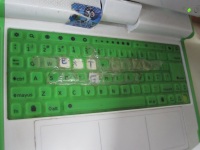
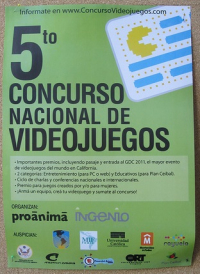


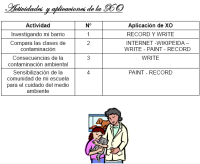
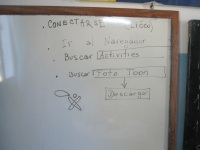
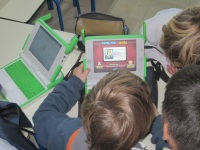
Christoph, I appreciate your detailed description of the OLPC project in Uruguay. Your article reminds us all that there is much more to successful ICT implementation than the purchase of computer equipment. In fact, computer purchases may make up only 20% to 30% of the actual implementation costs. You have aptly described the need for infrastructure, maintenance, content production, teaching training, and evaluation. Greater attention must be paid to helping teachers find, select, and integrate educational resources into their teaching. Although the Internet provides access to an abundance of material, this can be overwhelming to teachers who are, as you state, use to using one textbook for an entire course. They feel like many of us when faced with the question of where to park in a parking lot that has an abundance of empty spaces. But at Christmas time, when parking spaces near shops are scarce, we will take the first space that we see. Similarly, when faced with multiple resources, it can be time consuming and difficult to decide which to select. Thus, initially, teachers new to using technology may be provided links to a series of highly recommended primary resources that they can follow as well as lists of secondary resources that they can use as they become more comfortable with technology. I would also like to add that frequently, evaluators fail to recognize the impact ICT implementation has on the community. The ICT-based school can become the ICT centre for the community. Initially, the technology may be used to connect with relatives and friends, later to solve business challenges such as which market will sell their goods at the highest price, and finally to address needs related to self-improvement. Hopefully, the evaluations taking place will not just focus solely on the impact of ICTs on students and teachers, but also on families and rural communities. ICT implementation in schools can have a broader impact upon society.
Hi Clayton,
Have just been told that my comment was too long. That´s probably why you did not use paragraphs in yours.
So here goes the first bit:
Hi Clayton,
Almost fell-off my chair when I read your posting. I have been through Mr. Christoph's article in detail as I am working towards an MA in Education with the OU in the UK and one of my assingments is the use of Technology in rural areas. So i neatly went through the article expressing my opinions under each paragraph. That's the way I normally study.
And here goes the second half of my posting.
I also said in my comments that Mr. Derndorfer was extremely kind in his comments, though very precise. Mine were a lot more aggressive, but they were for my own use.
I am Uruguayan and have been back since 2005 after spending 18 years in different countries ranging from Brazil, the UK, and Mexico. I´m a Teacher Educator and materials writer. And the first thing I did when I arrived in Uruguay was to propose an educational experiment to the authorities. Never got a word back.
And here goes the final bit of my posting, as I was told it was still too long
Then in 2007 i ran a course called EDUCATIONAL USE OF ICT for teachers. It was a massive tour de force, but I managed to get some of them to get their certificate. When I announced it again in 2009 I had no takers, Uruguayans know everything. They suffer from what I call "the arrogance of ignorance".
I can guess from your name that you are not Uruguayan and maybe not even living in Uruguay at the moment, but your posting was so clear and well articulated, I am delighted you did it.
I would only like to get this info out to people in Uruguay so that they stop being ignorant. I shall certainly join this group which I have just done,
Cheers,
María Sara
Maria, thank you for your comments.
If I can provide some resources to assist you with your masters degree, let me know.
Best regards!
Nice writeup Christoph
It’s the old “curse of knowledge” dilemma isn’t it? It’s easy to assume visitors know how to comment or even that commenting is encouraged. Excellent post.
Mr. Christoph Derndorfer.
The vision you have about my country, Uruguay, resembles the vision a tourist would have, a kind of vision way too much optimistic.
Your romantic insight, and I suppose you are a romantic individual since you defend the OLPC program, does not match with the reality of my country, which once upon a time was called the American Switzerland, but I can assure you that nowadays is really far from being known that way anymore.
The “Plan Ceibal”, which was enforced and undemocratic, is one example of this. Its execution was imposed, and the kind of pressure that teachers are under because they didn’t agreed to follow this kind of “orthodoxy”, relates more to the kind of pressure that’s suffered in a country under a dictatorial government than a democratic one.
A one to one model project has never, as you should know, EVER given positive results at those places where it was implemented. It just represented a waste of money that a poor country like mine couldn’t afford, even less with these irresponsible experiments.
Come and live here, in Uruguay, and then you can have a real opinion. I even think that attitudes like those of getting countries that don’t even have their basic needs fulfilled (like Rwanda, with millions of children dying of starvation), enthusiastic about implementing this kind of programs, is a criminal act, because in the long term, this always gives more profit to those who have more in life.
Greetings from Uruguay, a poor country that doesn’t need computers. It needs so much more things before even thinking of them.
Don’t reply this, as I can’t read neither in german nor english.
Jorge Nelson Olivera
CI 1.669.386-7
BLOGUENTARIOS.
Jorge, your cynical view of Plan Ceibal hinders rather than helps. I've lived for many years in Uruguay, my wife is a Uruguayan educator and I've worked in the sector for many years. Yes, Uruguay's needs are vast and varied, but cutting off a viable, modern project would be regressive at a time when students need to prepare to compete in their very real futures that are already dominated by technology. Agreed, cronyism is rampant in Plan Ceibal, it's virtually impossible for outsiders with great ideas to assimilate into the project and the cardinal sin of premature hardware roll-out was committed before the more important provisions for maintenance/training/class integration were carefully thought through.But the base is there. I've been involved with VERY successful 1:1 programs. What bodes well for Uruguay is that these studies highlight the most common mistakes AND they admit to their problems. If they open their eyes to allow qualified people with alternative concepts to help and then pay them commensurate with their time and abilities, Plan Ceibal can become a worthwhile program.
Hi JPP,
My name is María Sara Rodríguez and I am Uruguayan although I spent 18 years abroad in different countries ranging from Brazil, the UK and Mexico.
I was horrified at what I saw of Education in Uruguay when I came back in 2004 and I am afraid I totally agree with Mr. Olivera. He is not being cynical. He describes reality. I have seen it myself in the past 5 years. AND THEY DON´T ADMIT TO THEIR PROBLEMS. Uruguayans suffer from what I call the "arrogance of ignorance". I am a Teacher Educator and ran the first ever ICT International Course for teachers of English between 2007 and 2009 called EDUCATIONAL USE OF ICT from EDI an International Examinations Board.
Am afraid I´ll have to send the rest of the reply separately as it is too long.
And here goes the second half.
I agree with your quote "If they….abilities". However, that is not what they are doing. Education in Uruguay is a hopeless mess, dominated by teachers´unions and they certainly don´t allow "qualified people….to help". I can tell you myself who having the qualifications and the experience was not allowed to help train the teachers for Plan Ceibal. No space to write more. I´d very much like to keep in touch and get to meet your wife. We might be able to do something for education in Uruguay, which is the reason why I came back.
María Sara Rodríguez
Tel: 2711 8072
email: masarod@gmail.com http://www.eltservicesla.com
And here goes the second half of my comment.
I agree with your quote "If they….abilities". However, that is not what they are doing. Education in Uruguay is a hopeless mess, dominated by teachers´unions and they certainly don´t allow "qualified people….to help". I can tell you myself who having the qualifications and the experience was not allowed to help train the teachers for Plan Ceibal. No space to write more. I´d very much like to keep in touch and get to meet your wife. We might be able to do something for education in Uruguay, which is the reason why I came back.
María Sara Rodríguez
Tel: 2711 8072
email: masarod@gmail.com <A href="http://www.eltservicesla.com target=_blank> <A href="http:// <a href="http://;www.eltservicesla.comemail:"” target=”_blank”>;www.eltservicesla.comemail:" target=_blank> <a href="http://;www.eltservicesla.comemail:” target=”_blank”>;www.eltservicesla.comemail: masarod@gmail.com
Estimado Sr. Olivera:
Mi nombre es María Sara Rodríguez y soy uruguaya aunque estuve 18 años fuera del país y volví a fines del 2004.
Espero que le llegue esta respuesta ya que no he seguido los comentarios a este artículo por unos cuantos meses porque estaba tratando de barajar a la vez una mastectomía + 6 quimios, una Maestría en Educación en línea, y un trabajo.
Tengo que cortar el comentario porque es muy largo.
Y aquí va el resto.
Sin embargo aún estoy aquí. Y acabo de recibir lo que escribió el Sr. Thompson, que luego ví que había escrito algo parecido en este "thread" ( no sé cómo se dice en español) y me encontré con su comentario.
Primero quiero FELICITARLO por su análisis. Me pareció ABSOLUTAMENTE BRILLANTE y LUCIDO y estoy totalmente de acuerdo. Me pareció particularmente agudo su comentario " A one to….irresponsible experiments"
Me gustaría entrar en contacto con Ud. porque desde que volví a Uruguay me he encontrado con poca gente que se exprese como Ud. Si mira arriba, yo ya había hecho unos comentarios al respecto.
Espero que le llegue esto. Entretanto le mando mi información.
Saludos y FELICITACIONES una vez más.
María Sara Rodríguez
1.306.335 -2
TEL: 2711 8072
Cel: (094) 377 572
email: masarod@gmail.com
P.D. Insólitamente tengo que hacer la tesis final para un MA en Educación, y decidí escribir sobre RWANDA!!!
Hi random musings,
I came across Mr. Derndorfer's article while scouring the Internet for an assignment I have to do for an MA in Education from the OU in the UK.
And was delighted to come across people like you. Have just joined the website. In the meantime I would like to hear what your colleagues have to say about the OLPC projects in Paraguay and Uruguay. I am Uruguayan and have been back since 2005 after spending time in Brazil, the Uk, Mexico and others. Can´t write any more because they´ll make me cut my postings.
You´ll get the rest in a minute.
Second half or they won´t allow me to post it. IMPORTANT: your link does not work. It says page not found. Will try and paste it in my browser.
As a final comment, I think the Plan Ceibal is "pathetic" and nobody knows what they are doing. It was just a "political ploy" It is really sad. Have not explored Paraguay or Perú yet so can´t say much. If any of your colleagues want "local information" I have some I could send you.
Cheers,
María Sara
Chris, Are you aware of any reports on the actual implementation process – in schools and classrooms? I'm interested in knowing more about how they actually approached teachers, principals and parents with the program during implementation. I haven't been able to find much in the Ceibal institutional page nor in the RAP group.
Hi Tel,
And you won´t. Because there ain´t any. Because as Nelson says, it is all a "political ploy". I´m Uruguayan, spent 18 years in countries ranging from Brazil, the UK and Mexico and still can´t get over the state I found education in Uruguay when I returned. Have you heard of an organisation called IQEA (Improving the Quality of Education for All)? I tried to set up a project with them when I got back in 2005, but, no, Uruguayans "know it all". They suffer from the "arrogance of ignorance" ( my coinage) Will dig up their website address and send it to you or you can google it. Can you read Spanish? Can send you some articles about Plan Ceibal if you want. Am a Teacher Educator and ran the first ever ICT course for teachers (an International Qualification from EDI) EDUCATIONAL USE OF ICT but they didn´t "need it". Lots more to tell if you are interested.
María Sara
Thank you for the discussions and debate. I'm from Canada and lived for a few short periods between 2007 and 2011 in Uruguay, and observed the Plan Ceibal in person. My main concern comes from a social economics point of view, examining the international division of labour. I tend to agree with Mr. Nelson's main concern about Uruguay needing many other things before OLPC.
My main reasons stem from observations about the exploitation by rich Northern countries of Southern nations. The Plan Ceibal seems to me to be very similar: it's main objectives could be articulated from this critical standpoint as being nothing less than the outsourcing of cheap IT-skilled labour to a poor an unequal partner in the global economy. Plan Ceibal appears to have less to do with educating the children – in a nation that is presently floudering and struggling to have a national vision and commensurate educational project – than it does with courting international favour. Uruguay is preparing a future in which the rich and dominant Northern economies can cheaply satisfy their IT-labour demands, and Plan Ceibal in this sense is an incubator not for future innovation and technology advancement, but training the labour force how to operate computers to provide service to the Northern economies.
Consider important facts that support this point of view: the project was proposed by a US businessman, Negroponte, and imposed in a top-down fashion by Uruguay's president, who is not an educator and was perhaps eager to seek foreign intervention; and the program was rolled out and laptops distributed without first appropriatly developing the program (mechanical problems, teacher and staff training, etc). Uruguay doesn't need OLPC – it need a home-grown, democratic and participative educational system based on a vision for the nation.
"it need a home-grown, democratic and participative educational system based on a vision for the nation".
don't we all… Please, Jordan, tell us where such thing exists so we can copy it? Very nice to say it needs it, but AFAIK, that's like asking for hipogrifs.
Hi, I´m Uruguayan although I spent 18 years abroad in countries from Brazil, the UK, Spain and Mexico.
I agree with your " Please Jordan,….copy it?" Am currently doing an MA in Education and I´m up to my ears in info about education around the world. Yes, you´re right. Tell me where it exists… Have you heard about an organisation called IQEA (Improving Education for All)? They´ve done fantastic work in many developing countries. Tried to do it in Uruguay, but no, Uruguayans know it all. They suffer from the "arrogance of ignorance" ( my coinage) Will fish the link to their website for you to have a look and send it to you.
Maria Sara